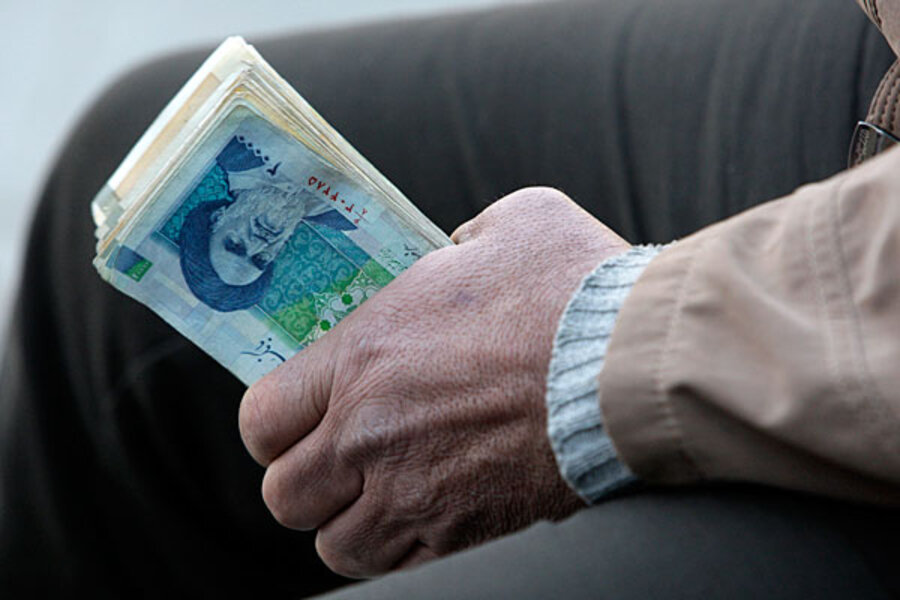What's causing Iran's currency to collapse?
Loading...
| Dubai
The Iranian currency fell to a record low on Tuesday as the Islamic republic struggles under the impact of Western economic sanctions and nervous citizens rushed to change their savings into hard currency.
The Iranian government blamed speculators for the rial's collapse and ordered the security services to take action against them.
President Mahmoud Ahmadinejad rejected criticism of his policies and insisted the country could ride out the sanctions, imposed because of Iran's nuclear programme, after the rial lost about a third of its value in a week.
"Enemies have managed to reduce our oil sales but hopefully we will compensate for this," a combative Ahmadinejad told a news conference. He suggested domestic criticism of him was part of a "psychological war" against Iran.
"According to a report from one of the security services, 22 individuals are ringleaders of the recent turmoil in the currency market, and since these individuals are known, security institutions must act," Ahmadinejad said.
The rial tumbled to a record low of around 37,500 to the U.S. dollar in the free market on Tuesday, from about 34,200 at the close of business on Monday, foreign exchange traders in Tehran said. On Monday last week, it traded at around 24,600.
Late on Tuesday, some Iranian media reported that the currency had recovered to around 32,000, but traders contacted by Reuters could not confirm this, saying they had stopped dealing because of the extreme volatility.
The rial's slide suggested the Western sanctions were doing serious damage to the country's economy.
On Sunday, Israeli Finance Minister Yuval Steinitz said Iran's economy was "on the verge of collapse".
By freezing Iran out of the global banking system, sanctions have made it hard for Tehran to obtain payment for its oil exports. Iranians have responded by rushing to change their savings into hard currency, fuelling the rial's slide.
"This is going to cause a shutdown in transactions in Iran. All the main distributors of electronics and household items will be concerned about trading - they'll want to know where the bottom is and how long it will continue," said Mehrdad Emadi, an Iranian-born economic adviser to the European Union who is based in Britain.
With Iran's official inflation rate running at around 25 percent, the rial's weakness threatens to increase the costs of industrial companies, worsening a recent spate of job losses in addition to reducing living standards.
Sanctions impact
But Ahmadinejad insisted on Tuesday that the impact of the sanctions had been manageable. Iran's imports totalled $26 billion in the first half of this year, down only moderately from $29 billion in the same period last year, he said.
"The central bank has provided all the currency for these imports," he said.
Many businessmen and ordinary citizens in Iran say the government is at least partly to blame for the currency crisis, and Ahmadinejad has been criticised for it by political enemies in parliament.
The rial has been depreciating for over a year and has lost about two-thirds of its value since June 2011. Its losses accelerated in the past week after the government launched an "exchange centre" to supply dollars to importers of basic goods; businessmen say the centre failed to meet demand for dollars.
"Eighty percent of our economic issues and problems are related to the system of management," parliamentary speaker Ali Larijani said on Tuesday, quoted by the Fars news agency.
Parliamentary news agency ICANA quoting Mohammad Bayatian, a member of parliament's industry and mines committee, as saying enough signatures had been collected to call Ahmadinejad to parliament for questioning over the rial's fall.
Iranian university students protested in front of parliament on Monday over a lack of government-subsidised dollars for their studies abroad, the Iranian Labour News Agency reported.
However, there is no clear sign that the criticism has reached a level that would force any change in the government.
The Iranian government has not released data showing the impact of the sanctions on living standards, but it can be glimpsed 150 kilometres (100 miles) across the Gulf in Dubai, traditionally a major centre of trade with Iran.
At the Dubai Creek, a crowded waterway from which motorised dhows ship goods to Iran, merchants said Iranian business had fallen off dramatically in the last two weeks.
"Everyone is losing; traders from Iran are losing because of the depreciating rial, and we're losing here because Iranians can't afford to buy our products any more," said Ahmed Mohammed Amin, 53, an Iranian trader who has lived in Dubai for 40 years.
"These are our worst days."





